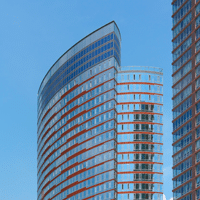Anthony Albanese built his first house when he was 19. As a product of the Great Depression and family loss at a young age, he became a hard worker in practice and attitude early in his life. When his brother Vincent completed law school in 1949, they started a construction business with Anthony handling the building and Vincent handling the legal matters. One by one, they built upon their successes until they eventually constructed the first condominium building in New York City to achieve LEED-NC Platinum status.
The Visionaire, completed in 2008 and certified a year later, is one of three Battery Park City projects, an urban portfolio that includes some of the Albanese Organization’s best and most recent work. Anthony, who died earlier this year, and Vincent started the company, but their sons are the ones continuing their fathers’ ideas about urban excellence and environmentally conscious design.
In 1979, Anthony’s son, Russell Albanese, joined the company after completing a bachelor of science degree in civil engineering at Duke University. “That’s when we were getting into Manhattan properties,” says Russell, who serves as chairman of the Albanese Organization. “We had just started our first high rise—100 United Nations Plaza—a 52-story residential condominium.” Vincent’s son Christopher Albanese also followed in his father’s footsteps and joined the company after law school. “Our backgrounds compliment each other’s like our fathers’ did,” Russell says.

The Visionaire’s water use is 50% less than a building of comparable size. Photos: The Albanese Organization
From the beginning, Anthony Albanese had a vision, and Russell and Christopher are committed to keeping that vision alive. “He always tried to find improvement from one project to the next,” Russell says. “He never looked to create cookie-cutter buildings and stamp those out. He was conscious about quality of life and trying to bring into residential homes and commercial spaces features that would enhance the environment and achieve efficiency of space. Decisions concerning design of building systems were always based on long-term durability, value, and efficiency over cost.”
This commitment to quality is what started the Albanese Organization on the path to sustainability. “We didn’t have a crystal ball, but we saw environmental issues becoming more important and critical in our daily lives, and that encouraged us to translate that into our business,” Russell says.
The Albanese Organization’s contribution to Battery Park City includes three high-rises: the Solaire (completed in 2003), the Visionaire (2008), and the Verdesian (2006), which were designed by Pelli Clarke Pelli Architects and built by Turner Construction Company. “The success of these buildings is largely attributable to a great team effort beginning with our public partner, the Battery Park City Authority, and our design, marketing, and construction professionals,” Russell says. “The continuity of the team in all three projects helped us build upon lessons learned and enabled us to refine and advance the green technologies with each building.”
Rafael Pelli, a partner at Pelli Clarke Pelli Architects, says, “We had weekly meetings with the Albanese Organization on all three buildings, which included not only design in the traditional sense, but a discussion of environmental strategies.” The result was a collaborative process that took input from many different perspectives.
The Visionaire is New York City’s first certified LEED Platinum condominium building. Key features of the 35-story, 500,000-square-foot property include an American Water waste-water-treatment plant, which recycles waste water to supply water to toilets and cooling towers, as well as an air purification system, a natural gas cooling-and-heating system, solar panels, and regenerative braking on elevators, which reduces electric consumption by one third. The building also has a microturbine that generates a portion of electricity for the building and utilizes energy recovered from combustion heat to heat domestic hot water. To top it off, it has a green roof that reduces rainwater runoff and utilizes harvested rainwater for irrigation. Overall, the building saves approximately 50 percent of water over a typical building and more than 35 percent in energy.
“With each building, we set out to apply lessons learned from the previous one and take advantage of new technologies, always improving upon what we have completed before,” Russell says. The company treated waste water and implemented other green measures at the Solaire, and Russell says the Albanese Organization’s previous experience resulted in significant cost savings when installing the Visionaire’s features.
Within each unit, a single master switch allows all in-unit lights to be managed from a central location. In public areas, occupancy sensor controls automatically raise and lower lights. The swimming pool uses a water-purification system that cuts down on chlorine use, and the building is cleaned with green materials. The Albanese Organization even gives each new resident a basket of green cleaning supplies for use in his or her home. The company also worked with a gourmet organic-food market to fill first-floor retail space. “We thought this would be an ideal use to help our residents live a green and healthier lifestyle,” Russell says.

